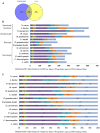Transcription Factor Repertoire of Necrotrophic Fungal Phytopathogen Ascochyta rabiei: Predominance of MYB Transcription Factors As Potential Regulators of Secretome
- PMID: 28659964
- PMCID: PMC5470089
- DOI: 10.3389/fpls.2017.01037
Transcription Factor Repertoire of Necrotrophic Fungal Phytopathogen Ascochyta rabiei: Predominance of MYB Transcription Factors As Potential Regulators of Secretome
Abstract
Transcription factors (TFs) are the key players in gene expression and their study is highly significant for shedding light on the molecular mechanisms and evolutionary history of organisms. During host-pathogen interaction, extensive reprogramming of gene expression facilitated by TFs is likely to occur in both host and pathogen. To date, the knowledge about TF repertoire in filamentous fungi is in infancy. The necrotrophic fungus Ascochyta rabiei, that causes destructive Ascochyta blight (AB) disease of chickpea (Cicer arietinum), demands more comprehensive study for better understanding of Ascochyta-legume pathosystem. In the present study, we performed the genome-wide identification and analysis of TFs in A. rabiei. Taking advantage of A. rabiei genome sequence, we used a bioinformatic approach to predict the TF repertoire of A. rabiei. For identification and classification of A. rabiei TFs, we designed a comprehensive pipeline using a combination of BLAST and InterProScan software. A total of 381 A. rabiei TFs were predicted and divided into 32 fungal specific families of TFs. The gene structure, domain organization and phylogenetic analysis of abundant families of A. rabiei TFs were also carried out. Comparative study of A. rabiei TFs with that of other necrotrophic, biotrophic, hemibiotrophic, symbiotic, and saprotrophic fungi was performed. It suggested presence of both conserved as well as unique features among them. Moreover, cis-acting elements on promoter sequences of earlier predicted A. rabiei secretome were also identified. With the help of published A. rabiei transcriptome data, the differential expression of TF and secretory protein coding genes was analyzed. Furthermore, comprehensive expression analysis of few selected A. rabiei TFs using quantitative real-time polymerase chain reaction revealed variety of expression patterns during host colonization. These genes were expressed in at least one of the time points tested post infection. Overall, this study illustrates the first genome-wide identification and analysis of TF repertoire of A. rabiei. This work would provide the basis for further studies to dissect role of TFs in the molecular mechanisms during A. rabiei-chickpea interactions.
Keywords: Ascochyta rabiei; cis-acting elements; necrotrophic fungi; plant–pathogen interaction; secretome; transcription factors.
Figures











Similar articles
-
Draft genome sequencing and secretome analysis of fungal phytopathogen Ascochyta rabiei provides insight into the necrotrophic effector repertoire.Sci Rep. 2016 Apr 19;6:24638. doi: 10.1038/srep24638. Sci Rep. 2016. PMID: 27091329 Free PMC article.
-
Ascochyta rabiei: A threat to global chickpea production.Mol Plant Pathol. 2022 Sep;23(9):1241-1261. doi: 10.1111/mpp.13235. Epub 2022 Jul 1. Mol Plant Pathol. 2022. PMID: 35778851 Free PMC article. Review.
-
Genetic Analysis of Partially Resistant and Susceptible Chickpea Cultivars in Response to Ascochyta rabiei Infection.Int J Mol Sci. 2024 Jan 22;25(2):1360. doi: 10.3390/ijms25021360. Int J Mol Sci. 2024. PMID: 38279360 Free PMC article.
-
In planta Identification of Putative Pathogenicity Factors from the Chickpea Pathogen Ascochyta rabiei by De novo Transcriptome Sequencing Using RNA-Seq and Massive Analysis of cDNA Ends.Front Microbiol. 2015 Dec 1;6:1329. doi: 10.3389/fmicb.2015.01329. eCollection 2015. Front Microbiol. 2015. PMID: 26648917 Free PMC article.
-
Expression profiling of chickpea genes differentially regulated during a resistance response to Ascochyta rabiei.Plant Biotechnol J. 2006 Nov;4(6):647-66. doi: 10.1111/j.1467-7652.2006.00208.x. Plant Biotechnol J. 2006. PMID: 17309735 Review.
Cited by
-
Comparative Transcriptome Analysis of Onion in Response to Infection by Alternaria porri (Ellis) Cifferi.Front Plant Sci. 2022 Apr 11;13:857306. doi: 10.3389/fpls.2022.857306. eCollection 2022. Front Plant Sci. 2022. PMID: 35481153 Free PMC article.
-
Genome-Wide Characterization and Comparative Analysis of MYB Transcription Factors in Ganoderma Species.G3 (Bethesda). 2020 Aug 5;10(8):2653-2660. doi: 10.1534/g3.120.401372. G3 (Bethesda). 2020. PMID: 32471942 Free PMC article.
-
Fungal Coculture: Unlocking the Potential for Efficient Bioconversion of Lignocellulosic Biomass.J Fungi (Basel). 2025 Jun 17;11(6):458. doi: 10.3390/jof11060458. J Fungi (Basel). 2025. PMID: 40558970 Free PMC article. Review.
-
Genome-Wide Characterization and Expression Analyses of Pleurotus ostreatus MYB Transcription Factors during Developmental Stages and under Heat Stress Based on de novo Sequenced Genome.Int J Mol Sci. 2018 Jul 14;19(7):2052. doi: 10.3390/ijms19072052. Int J Mol Sci. 2018. PMID: 30011913 Free PMC article.
-
Independent Evolution of the MYB Family in Brown Algae.Front Genet. 2022 Feb 4;12:811993. doi: 10.3389/fgene.2021.811993. eCollection 2021. Front Genet. 2022. PMID: 35186015 Free PMC article.
References
-
- Adryan B., Teichmann S. A. (2006). FlyTF: a systematic review of site-specific transcription factors in the fruit fly Drosophila melanogaster. Bioinformatics 22 1532–1533. - PubMed
-
- Asano Y., Hagiwara D., Yamashino T., Mizuno T. (2007). Characterization of the bZip-type transcription factor NapA with reference to oxidative stress response in Aspergillus nidulans. Biosci. Biotechnol. Biochem. 71 1800–1803. - PubMed
-
- Bok J. W., Wiemann P., Garvey G. S., Lim F. Y., Haas B., Wortman J., et al. (2014). Illumina identification of RsrA, a conserved C2H2 transcription factor coordinating the NapA mediated oxidative stress signaling pathway in Aspergillus. BMC Genomics 15:1011 10.1186/1471-2164-15-1011 - DOI - PMC - PubMed
LinkOut - more resources
Full Text Sources
Other Literature Sources
Research Materials
Miscellaneous

